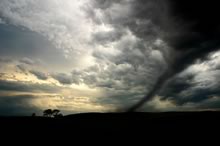

Provided by NOAA’s
National Weather Service
Facts
- Produce wind speeds in excess of 250 mph.
- Can be one mile wide and stay on the ground over 50 miles.
- Tornadoes can occur any time of year.
- Tornadoes have occurred in every state, but they are most frequent east of the Rocky Mountains during the spring and summer months.
- In the southern states, peak tornado occurrence is March through May, while peak months in the northern states are during the late spring and summer.
- Tornadoes are most likely to occur between 3 pm and 9 pm, but can happen any time.
Preparedness
- Ask a campground staff member what they have in place to notify campers of a severe weather warning. If the alarm system relies on electricity, ask if they have an alternate method to notify campers in case of a power failure.
- Identify a shelter area where you should go in case of imminent severe weather.
- NOAA Weather Radio is the best means to receive warnings from the National Weather Service.
- NOAA’s National Weather Service watches and warnings are also available on the Internet at www.weather.gov.
- Listen to radio and television for weather information.
- Check the weather forecast before leaving for extended periods outdoors. Watch for signs of approaching storms.
Definitions
- Tornado Watch: Severe thunderstorms with the potential to produce tornadoes are possible in your area. Remain alert for approaching storms. Know what counties or parishes are in the watch area by listening to NOAA Weather Radio or your local radio/television outlets.
- Tornado Warning: A tornado has been sighted by spotters or indicated by weather radar.
Click for more information regarding tornadoes from the American Red Cross
